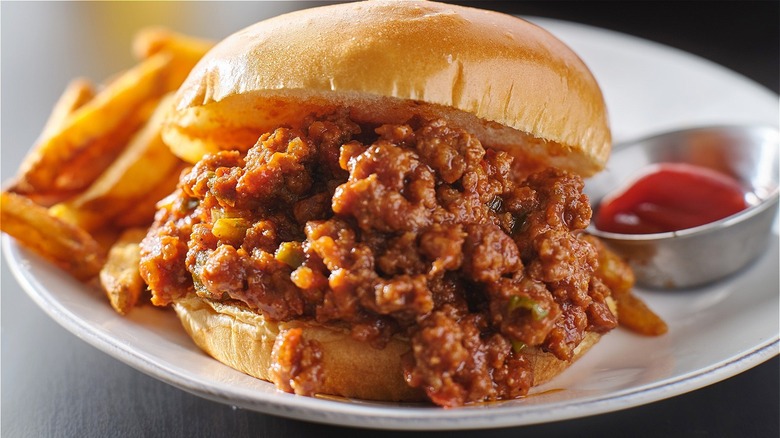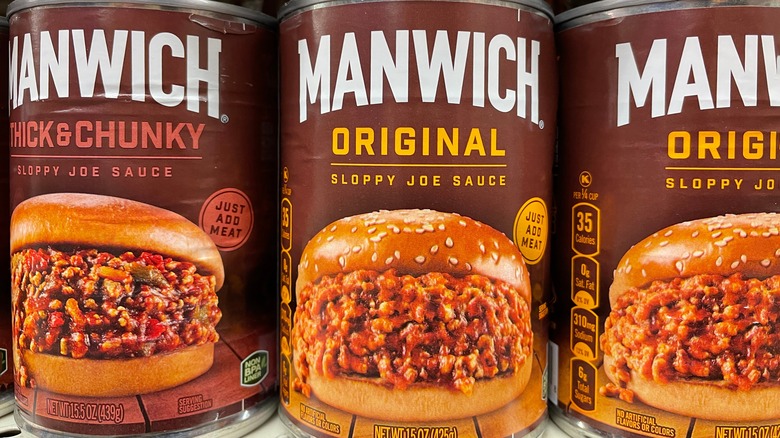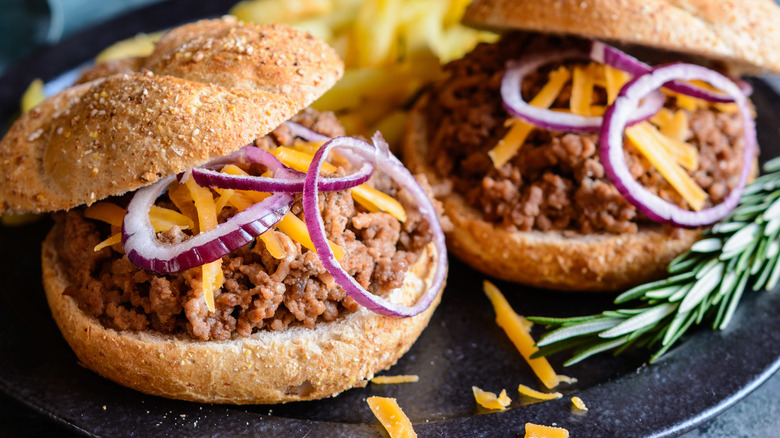Sloppy Joes: A '90s Lunchroom Classic That Turned Into A Modern-Day Homemade Hero
The school cafeteria was the stage for many greats: rectangular pizza, crunchy tacos, and, of course, Sloppy Joes. Always served with a little carton of milk, these lunches were '90s icons. Many of these nostalgic meals have fallen out of fashion, but there is no reason for Sloppy Joes to suffer the same fate. They are quick to make, affordable, flavorful, and, let's be honest, a super fun throwback.
According to Wonderopolis, the origin of Sloppy Joes is attributed to either Sioux City, Iowa, or Havana, Cuba. In the 1930s, the "loose meat" sandwich was a popular dish at Midwestern lunch counters. Adding fillers to the ground meat allowed restaurants to stretch the protein, per Blue Apron. It is said that Joe, a cook at Floyd Angell's cafe, added tomato sauce to the meat mixture, thus creating the Sloppy Joe.
The other possibility comes from Jose Garcia's Havana bar, where he served a sandwich inspired by the Cuban dish ropa vieja (via SloppyJoes.org). Because Garcia also sold seafood kept on ice that would eventually melt, his wet-floored restaurant became known as being "sloppy." The bar was renamed Sloppy Joe's at the suggestion of famous guest Ernest Hemingway. Hemingway also proposed renaming another spot he frequented, Sloppy Joe's restaurant in Key West, Florida. The Prohibition-era bar was originally run by Joe Russell and given the same name in honor of the original Sloppy Joe's in Havana.
Sloppy Joes quickly became a classic
Sloppy Joes continued to rise in popularity through the mid-1900s across weeknight dinner tables and school cafeteria lunches. The South Florida Reporter notes that there are many other names for the messy sandwich, including "barbecues, dynamites, gulash, sloppy janes, slushburgers, steamers, wimpies, and yum yums," as well as the famous Manwich. According to Foodimentary, this canned Heinz product hit the shelves in 1969 and included all the ingredients for the Sloppy Joe sauce — just add ground beef. In fact, Manwich helped Sloppy Joes skyrocket into popularity, as people could now easily recreate their favorite diner order at home.
Sloppy Joes likely became a cafeteria mainstay because of the balance between heartiness of the meal and its affordability. As Robert Jaber of the District of Columbia Public Schools' food and nutrition services office said, "The Sloppy Joe, if served properly, can be the perfect combination of economics, nutrition, heartiness, and student acceptance — it's a perfect fit for a school menu" (via Blue Apron).
Sloppy Joes should be a staple in your dinner rotation
Cafeteria food does garner a bad reputation, and Sloppy Joes seem to be guilty by association. While our meaty Sloppy Joes recipe contains added sugar in the form of ketchup and brown sugar, the ingredients are otherwise pretty standard, and they can be swapped or enhanced with more nutritious options. Recipe developer Michelle McGlinn points out that the classic addition of red and green bell peppers along with green can adds color and crunch while still being appealing to kids. Use lean ground beef, turkey, a plant-based protein, or a combination.
Plus, as recipe developer Kristin Carli notes in Mashed's old-fashioned Sloppy Joes recipe, the mixture lends itself to the addition of some undercover vegetable components to boost flavor and nutrients. She suggests adding subtle yet nutritious items like mushrooms or even lentils. Whatever combo you decide to try, your Sloppy Joe mixture should come together in one pot and will be ready in no time to spoon onto a classic bun or baked potato, served with the full cafeteria throwback of tater tots and celery sticks. Consider this a petition to bring Sloppy Joes into the modern day: They're a tasty, fun, adaptable one-pot dish, and in less than 30 minutes, you've got a homemade meal on the table.


